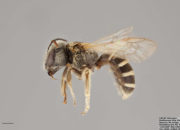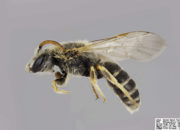This is perhaps one of the most common wild bees in Vermont, especially in warmer and more developed areas. It seems to prefer loose soil for nesting and is consequently less ubiquitous in areas with extensive clay. The massive head of the female makes for a unique gestalt that is readily identifiable.
Identification: Females are best recognized by the very large head and cheeks with a small but distinct spine on the lower rear corner. Males have a distinctive combination of yellow on the clypeus and tibia, orange on the underside of the antenna, and dark front femurs.
Similar Species: Both males and females share some traits with the two other common Furrow Bees in VT, but can usually be separated by the characters above. See also Lasioglossum and Andrena.
Known or Suspected Hosts/Parasites:
Global Status: Secure (G5)
Vermont Status: Not Ranked
For more information, visit the following links:
Discover Life
Living Atlas Species Page
Distribution: To see the global distribution, check out the iNaturalist account, and toggle the GBIF layer on the map.








